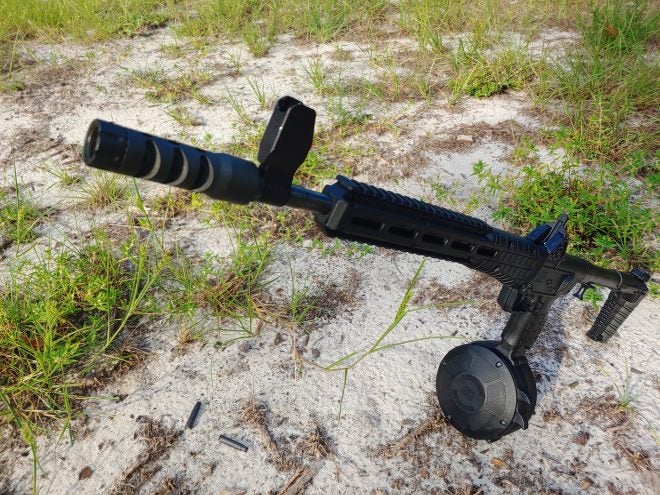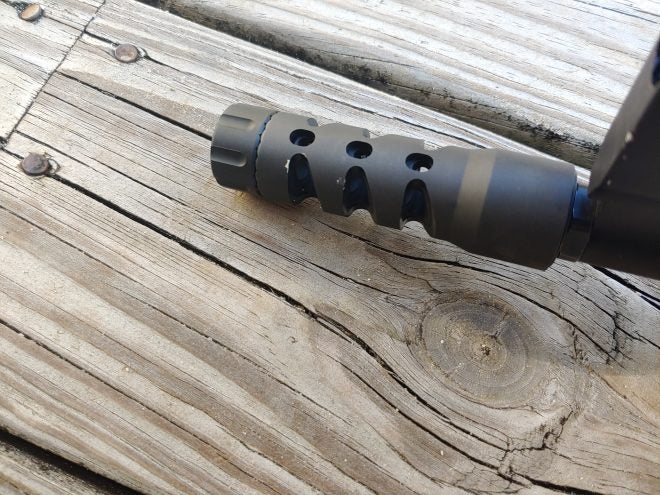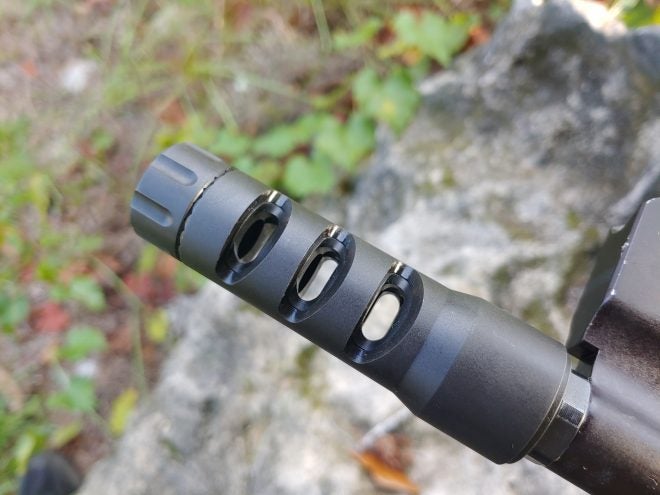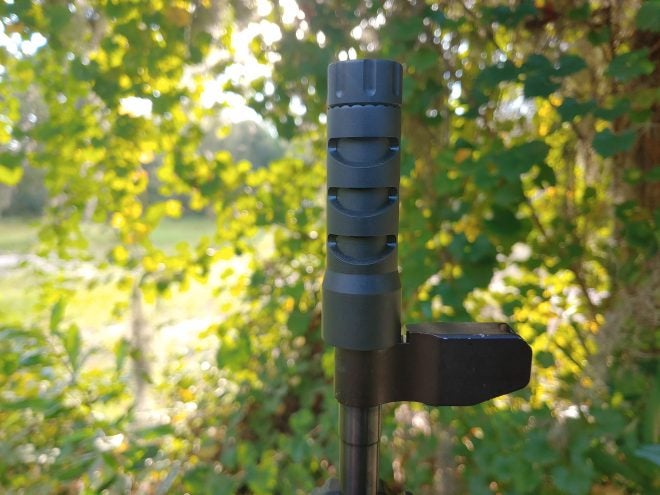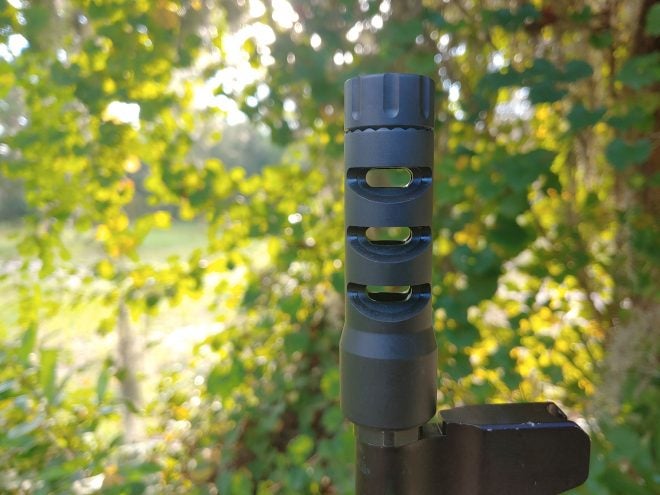The Regulator by Matador Arms — Adjust it
Travis Pike 01.15.20
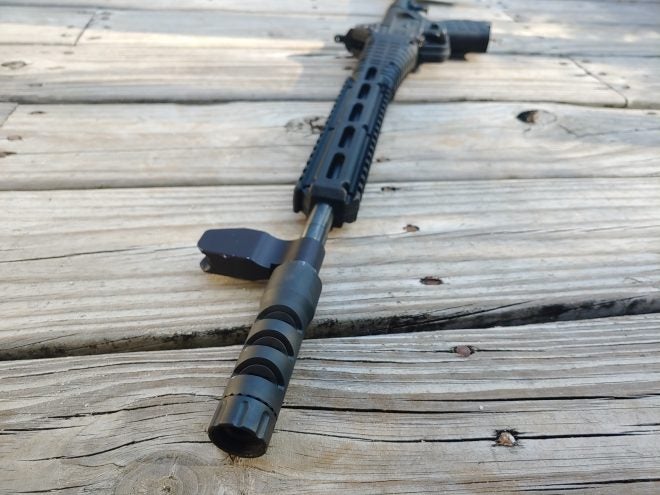
Matador Arms is a little Canadian company that makes some excellent products. They are a small company, but their products are outstanding and often very innovative. The Regulator is a new muzzle device that’s designed to be adjustable. Adjustable muzzle devices aren’t exactly new, but the Regulators take on the design is. Most adjustable muzzle devices require a tool and small screws that block specific ports. The Regulator requires no tools to adjust and can be adjusted to over 60 different positions. The Regulator comes in 9mm, 5.56, 308, and 6.5.
It’s a four-piece system. It is compromised of the brake, a small spring, a cover, and a locking nut. Installation is quick and straightforward, but I won’t bore you with that. The instructions are easy to follow.
The locknut is the key to adjusting the brake. If you start with it tightened all the way down the brake will be fully closed. As you turn the locknut the spring will push the cover forward and reveal the ports. It’s simple and easy to adjust.
The Regulator and 60+ Settings?
60+ settings seem to be a bit much right? It’s not a lie, but most of us don’t need 60+ different settings. The settings are each a turn of the locknut that will slowly grow the ports as you adjust it. Technically you can count each turn a setting, but it’s a bit generous.
That’s not to take away from the Regulator, and it just ensures you understand what the settings are considered. I installed the Regulator on my Kel-Tec SUB 2k. It was one of the few guns I had lacking a muzzle device, and I wanted to see if the device could make a difference on something as light as a 9mm rifle.
The brake is made up of 9 different ports. There are three on the right and left side of the brake and three on top of the device. The Regulator acts as both a compensator and a muzzle brake. These hybrid designs will reduce both muzzle rise and recoil. Once Installed, and properly shimmed, I hit the range to see what the benefits of the Regulator.
Playing with Adjustment
I hit the gun range early in the morning, right after the sun had risen. The light was mild, and I chose this time for a reason. One of the downsides of these devices is that they tend to create a bit of flash, making it uncomfortable for the shooter in low light situations. On top of that, I chose some hotter Winchester 9mm NATO loads to see some flash.
Fully Closed
Fully closed, there is no flash, and of course no recoil or muzzle rise reduction. That doesn’t mean this isn’t a handy setting. Having it fully closed also prevents the famously loud nature of brakes. A closed Regulator would work great in an indoor range by cutting noise. It’s neighborly to your fellow range mates. Also in low light, there is no flash visible to the shooter.
Opened Halfway
Carefully opening the break to the halfways position gives you moderate recoil and muzzle reduction. There is very clearly a noticeable difference. Muzzle rise is very mild, and the sights move a hair off target before instantly resettling back on target. Also, no noticeable muzzle flash in the half-opened position. It was admittedly brake-like in its noise level. Even with my Peltor 500s on, I noticed the difference between port positions.
Fully Opened
Dialing this bad boy to 11 is where we saw a massive difference. With the device fully opened, there is almost no muzzle rise. The front sight shakes a little, and that’s it. It was impressive. I dialed back to fully closed fired three shots rapidly and then opened it fully and fire three rapid shots. The difference between the two is significant. Another difference is most certainly the noise. It’s much louder and more abrasive. There was also no noticeable flash, but in actual low light scenarios, there may be a difference. There is a noticeable difference in the gas released. The gas can come back and hit you in the face, causing discomfort.
Downsides
The device is quite long and a little hefty. It weighs 6.8 ounces and is 3.6 inches long. It’s also 1.08 inches in diameter. These dimensions take the Regulator out of most competition circuits. Also, as you imagine rotating and adjusting the Regulator can be dangerous if it’s hot from a day at the range, so be cautious. Also, as you’d imagine, you have to be careful not to flag yourself with the muzzle. You should also clear the weapon before operating the Regulator.
Final Thoughts
A 9mm muzzle brake is a bit much, but it did make a noticeable difference. Delivering a half dozen rounds on target with minimal muzzle movement is helpful. The Regulator would be better suited on more powerful weapons, but I shoot 9mm way more than I shoot 308. The Regulator is well made, and the design is somewhat ingenious. Being able to change how your break functions on the fly. It allows you to compromise between muzzle rise and recoil reduction and the presence of flash, noise, and gas. The Regulator is unique as far as muzzle devices go, and I do tend to appreciate innovative ideas.
